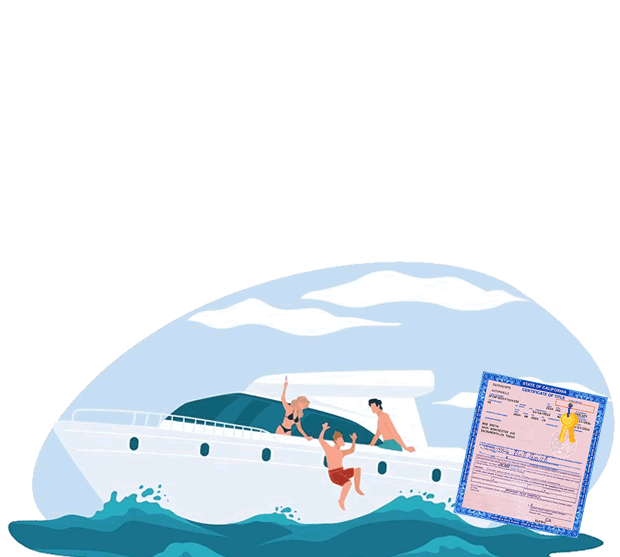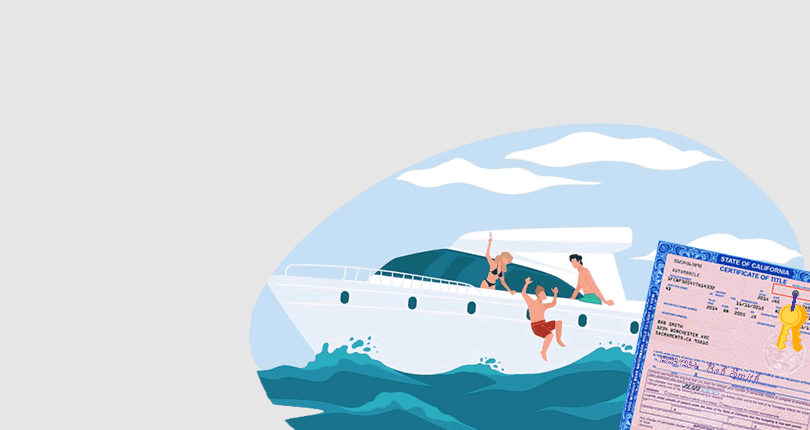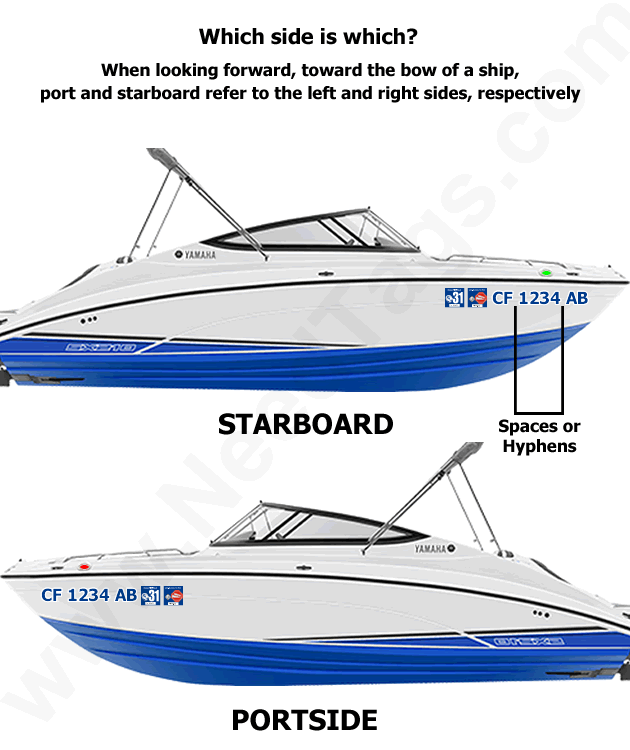CA California Vessel Title Transfer Online
Fast, Simple, and Secure Vessel Title Transfer | Officially Licensed by the CA DMV 


Transfer your vessel title faster and easier online.
California Department of Motor Vehicles services delegated to NeedTags
Instant Registration Card Download a digital copy of your new CA DMV registration card instantly. You can print out your e-Card or display it on your mobile device anytime.
Expedited DMV ProcessingGet DMV tags as fast as next day with API driven technology. Our proprietary platform is built to expedite the processing of your vessel's registration.
Anytime Fee PaymentNeed a smog check or haven't bought insurance? Not a problem. We can post DMV fees and provide immediate proof of ownership.
Shipping AnywhereIt's ok if you recently moved. NeedTags can ship your new California vehicle registration card and sticker to any address in all 50 States.
Personal AssistanceMissing documents? Paperwork incomplete? We can fix it! A dedicated agent will ensure your title transfer experience is stress-free.
How To Transfer a Vessel or Boat Title in California
What types of boats need to be registered in California?
If you own a boat/vessel with a motor or a sailboat over eight feet long, California requires that it be registered either with the Department of Motor Vehicles or the United States Coast Guard (Coast Guard registration applies to commercial boats/vessels only).
Examples of boats/vessel which require California registration:
Commercial boats/vessels that weigh more than five net tons and are longer than 30 feet must be registered (documented) by the U.S. Coast Guard. Do not apply for registration with the California Department of Motor Vehicles.
Examples of boats/vessel which require California registration:
- Sail-powered boat/vessel that is over eight (8) feet long
- Vessel/boat with a motor (regardless of engine size/hp)
- Dinghies
- Houseboats that have a motor
- Rowboats, canoes, or any boat or vessel that use paddles or oars
- Sailboats that are shorter than eight (8) feet (Check your Certificate of Number or Certificate of Title for exact boat length)
- Parasails or sailboards
- Lifeboats which is strictly used on a ships
- Boats which are used at amusement parks and connected to rails
- Floating structures that are tied to land and use on-shore power, water, and a sewage system
Commercial boats/vessels that weigh more than five net tons and are longer than 30 feet must be registered (documented) by the U.S. Coast Guard. Do not apply for registration with the California Department of Motor Vehicles.
I bought a used boat. How do I transfer ownership to my name?
The process is called a Title Transfer and it's simple to do. You can transfer a vessel title online through NeedTags.com in three easy steps. Before you begin, make sure you have these important documents:
Certificate of Title - You'll need the vessel's Certificate of Title, showing that the seller is the boat's true owner. Their name must be on the document. The certificate of title is in essence proof of ownership and is needed to register the vessel in your name. You must ensure there is no second name on the title. If there are two names which are separated by an "AND" or "/" you will need to obtain signatures from both owners before the transfer can be made legal. Two names separated by an "OR" allows either owner (seller) to sell the vessel and either owner may sign the title's "release of ownership/interest" section.
A certificate of title is often referred to as a pink slip. Both terms mean the same thing and we refer to them both as simply a vessel title. Assuming the seller gave you a title when you bought the boat or watercraft, ensure they signed on line one (1). Line one (1) indicates "Release of Ownership". The seller must sign line one (1) or line one (1) and line two (2); in the case of two owners. The DMV will not transfer the vessel title without these signature(s).
Bill of Sale - Next, you should have a Bill of Sale (REG 135). A bill-of-sale is not required by the DMV in order to transfer a vessel's title but is highly recommended for the purpose of "proof of purchase" and record keeping. Complete a detailed bill of sale and have the seller sign it, for your protection. A Bill-of-Sale can be written by you or the seller but must be signed by both. You may draft a bill of sale yourself or download one prepared by the State of California DMV from our DMV Forms download page.
I have my documents. What's next? Once you have these documents in order and are ready to pay title transfer fees you may begin the title transfer process. Start the process online through NeedTags.com® or by visiting a local DMV service provider or DMV branch office. Unless your transfer has special circumstance(s), the two documents above will suffice in getting the vessel's title transferred to your name. We discuss family and out-of-state title transfers later. The process is similar except an additional document or two is required. For DMV in-person service, please make a DMV appointment.
Certificate of Title - You'll need the vessel's Certificate of Title, showing that the seller is the boat's true owner. Their name must be on the document. The certificate of title is in essence proof of ownership and is needed to register the vessel in your name. You must ensure there is no second name on the title. If there are two names which are separated by an "AND" or "/" you will need to obtain signatures from both owners before the transfer can be made legal. Two names separated by an "OR" allows either owner (seller) to sell the vessel and either owner may sign the title's "release of ownership/interest" section.
A certificate of title is often referred to as a pink slip. Both terms mean the same thing and we refer to them both as simply a vessel title. Assuming the seller gave you a title when you bought the boat or watercraft, ensure they signed on line one (1). Line one (1) indicates "Release of Ownership". The seller must sign line one (1) or line one (1) and line two (2); in the case of two owners. The DMV will not transfer the vessel title without these signature(s).
Bill of Sale - Next, you should have a Bill of Sale (REG 135). A bill-of-sale is not required by the DMV in order to transfer a vessel's title but is highly recommended for the purpose of "proof of purchase" and record keeping. Complete a detailed bill of sale and have the seller sign it, for your protection. A Bill-of-Sale can be written by you or the seller but must be signed by both. You may draft a bill of sale yourself or download one prepared by the State of California DMV from our DMV Forms download page.
I have my documents. What's next? Once you have these documents in order and are ready to pay title transfer fees you may begin the title transfer process. Start the process online through NeedTags.com® or by visiting a local DMV service provider or DMV branch office. Unless your transfer has special circumstance(s), the two documents above will suffice in getting the vessel's title transferred to your name. We discuss family and out-of-state title transfers later. The process is similar except an additional document or two is required. For DMV in-person service, please make a DMV appointment.
What is important to include in a Bill of Sale?
We recommend you include the following important information in your bill of sale:
Give a copy of the bill of sale to the seller and keep the original for yourself. If you don't have access to a copy machine, complete two bill of sales and have the seller sign them both. Should the need arise this information in writing will be invaluable.
- Date of purchase.
- Seller name and address.
- Buyer name and address.
- Vessel description, including make, model, year, hull identification number (HIN), and CF number. You may also want to notate the vessel's color and any distinguishing marks and/or features.
- Sale condition, i.e. sold "as-is", sold with warranty and indicating the time-period, sold with damage to motor or hull, and so on.
- If the seller purchased the vessel but never registered it in their name, the bill of sale should include the previous owner(s) information.
- The amount paid for the vessel, including any payments made in installments or down payment.
- How payment(s) were made, i.e. cash, check, credit card or direct deposit.
- Most importantly, ensure the bill-of-sale is signed by both you and the seller.
Give a copy of the bill of sale to the seller and keep the original for yourself. If you don't have access to a copy machine, complete two bill of sales and have the seller sign them both. Should the need arise this information in writing will be invaluable.
How much will it cost to transfer my boat title in California?
After acquiring or buying a new or used boat, vessel, or watercraft you will need to pay the California DMV all applicable registration fees and use tax. The total amount due will be based on the vessel's purchase price, sale date, and registration county.
Registration fees may be due if the vessel you purchased or have acquired has expired registration or registration which is about to expire (75 days or less). If renewal fees or initial registration fees are due for the vessel, the DMV will require you to pay registration fees alongside the use tax and transfer fee. Vessel registration fees are indicated below:
- Use Tax – Between 7.5% - 10%. Tax collected by the county in which you indent to register your vessel.
- Transfer Fee – $15.00 DMV fee charge to perform a title transfer.
- Registration Fee – Does not apply in all cases. Read about registration fees in the paragraph below.
Registration fees may be due if the vessel you purchased or have acquired has expired registration or registration which is about to expire (75 days or less). If renewal fees or initial registration fees are due for the vessel, the DMV will require you to pay registration fees alongside the use tax and transfer fee. Vessel registration fees are indicated below:
Initial Registration (Resident)
Sold in Even Year$29.00
Sold in Odd Year$49.00
Penalty - Sold in Even Year$10.00
Penalty - Sold in Odd Year$25.00
Initial Registration (Non-Resident)
Sold in Even Year$57.00
Sold in Odd Year$77.00
Penalty - Sold in Even Year$24.00
Penalty - Sold in Odd Year$39.00
Registration Renewal
Biennial renewal (due in odd years)$20.00
Penalty$10.00
Boat/Vessel Title Transfer
Change of Ownership$15.00
Penalty$8.00
Will I receive a new vessel year stickers with my title transfer? How should I display it on my boat?
When transferring title through NeedTags, and if your boat/vessel requires initial registration or registration renewal, in addition to receiving your vessel Certificate of Number registration card and Certificate of Title, you will also receive two (2) vessel registration stickers. You'll need to place the stickers on both sides of your boat/vessel (starboard and portside), three inches apart from your vessel registration number (CF number). Your registration stickers must be clearly visible at all times. Other than your vessel CF number, do not place any numbers, letters, or devices near the registration sticker. Similar to a vehicle's license plates, a vessel's CF numbers and registration stickers must be clearly visible while in operation.

How do I find my boat's Hull Identification Number (HIN)?
The HIN is typically found on a metal or plastic plate, on the transom of the boat, usually on the starboard (right) side within two (2) inches of the top of transom. On vessels without transoms, the HIN is usually affixed to the starboard (right) outboard side of hull, aft, within one foot of the stern and within two inches of the top of the hull side. On catamarans and pontoon boats with replaceable hulls, the HIN is usually affixed to the aft crossbeam, within one (1) foot of the starboard (right) hull attachment. Boats manufactured or imported on or after August 1, 1984 also have a duplicate secondary HIN affixed somewhere on an unexposed location inside the boat or beneath a fitting or item of hardware/furniture/appliance.
Do I need to have insurance on my boat in order to change ownership to my name?
While boat insurance or personal watercraft insurance is not a requirement by law in the State of California, for title transfer or initial vessel registration, it is highly advisable since not being insured comes with a measure of risk. In the event of a collision or damage to the vessel or to yourself and others, boat/vessel/jet ski insurance (also known as PWC Insurance) offers similar coverage to that of an automobile:
- Collision
- Liability
- Comprehensive
- Medical
- On-water towing and labor
- Emergency
How do I transfer ownership of my vessel to a family member?
Title transfer between family members require the same process as title transfer between private parties except such as when a vessel is gifted, no use tax will be due. You will need to complete and sign a Statement of Facts Form (REG 256) in order to claim your use tax exemption, if applicable. The California DMV describes family members as: spouse, domestic partner, sibling, child, parent, grandparent, or grandchild.
Who handles the DMV paperwork if I buy a boat, sea-doo, waverunner, or other watercraft from a dealership?
Watercraft and boat dealers in California collect DMV fees and process registration for vessel's they sell. They often hire local DMV service providers to process these transaction for them. Your purchase contract should include a list of itemized DMV fees. Your new certificate of title should be arriving between 6 to 8 weeks. Contact the DMV or the dealership you purchased the vessel from if you don't receive your vessel's new title within this time frame.
The seller claims they lost the pink slip. Should I still buy the boat without it?
Use caution when purchasing a vessel without title. Unless you are absolutely certain that the seller is the vessel's owner we'd recommend advising them to apply for a duplicate title and complete the purchase only after they can provide it to you. The DMV can and will transfer a vessel's ownership without a title, but it's always recommended to have one. If you've already made the purchase without a title, you can complete the transfer process by using a Duplicate Title Request Form (REG 227) in lieu of the original. The Duplicate Title Request Form (REG 227) must be signed by both you and the seller in order to be valid and accepted by the DMV. You may need to contact the seller to get the form signed. If you have not made the purchase yet, have this form ready with you before you pay for the boat or ask the seller to have one prepared. You may download a REG 227 from our download forms page. If a lienholder release is required, REG 227 will also need to be notarized.
How much time do I have to change ownership? Is there a penalty if I'm late?
For the buyer -
If you recently purchased or were given a vessel either from a family member or private party, you have 10 days from the date of sale/acquisition to report the change of ownership to the DMV. You must also pay transfer fees within 30 days of the sale/acquisition date to avoid transfer and use tax penalties. It is not necessary to have all your title transfer documents filed with the DMV in 30 days, but it is necessary to pay your title transfer fee and use tax, if applicable.
For the seller - Your requirement is to complete and submit either in person, online, or by mail a Notice of Transfer and Release of Liability (REG 138) to the DMV within 5 days of the sale/gift/trade date. Your name will be on DMV record until the new owner pays transfer fees and completes the title transfer process however REG 138 will relieve you of responsibility for civil or criminal actions involving the vessel after you've sold, gifted, or traded it.
For the seller - Your requirement is to complete and submit either in person, online, or by mail a Notice of Transfer and Release of Liability (REG 138) to the DMV within 5 days of the sale/gift/trade date. Your name will be on DMV record until the new owner pays transfer fees and completes the title transfer process however REG 138 will relieve you of responsibility for civil or criminal actions involving the vessel after you've sold, gifted, or traded it.


